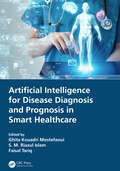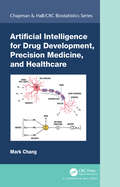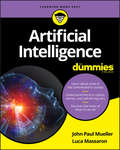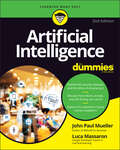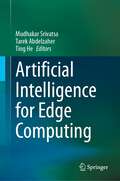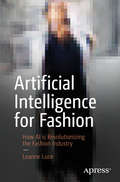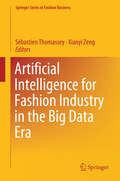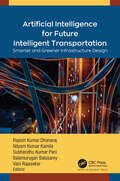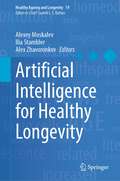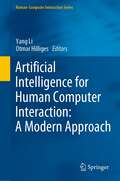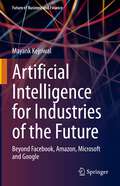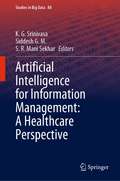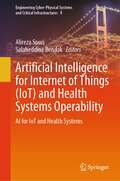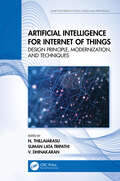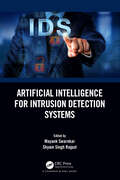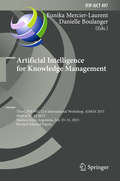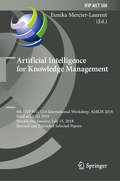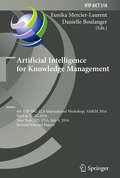- Table View
- List View
Artificial Intelligence for Disease Diagnosis and Prognosis in Smart Healthcare
by Ghita Kouadri Mostefaoui S. M. Riazul Islam Faisal TariqArtificial Intelligence (AI) in general and machine learning (ML) and deep learning (DL) in particular and related digital technologies are a couple of fledging paradigms that next-generation healthcare services are sprinting towards. These digital technologies can transform various aspects of healthcare, leveraging advances in computing and communication power. With a new spectrum of business opportunities, AI-powered healthcare services will improve the lives of patients, their families, and societies. However, the application of AI in the healthcare field requires special attention given the direct implication with human life and well-being. Rapid progress in AI leads to the possibility of exploiting healthcare data for designing practical tools for automated diagnosis of chronic diseases such as dementia and diabetes. This book highlights the current research trends in applying AI models in various disease diagnoses and prognoses to provide enhanced healthcare solutions. The primary audience of the book are postgraduate students and researchers in the broad domain of healthcare technologies. Features In-depth coverage of the role of AI in smart healthcare Research guidelines for AI and data science researchers/practitioners interested in the healthcare sector Comprehensive coverage on security and privacy issues for AI in smart healthcare
Artificial Intelligence for Drug Development, Precision Medicine, and Healthcare (Chapman & Hall/CRC Biostatistics Series)
by Mark ChangArtificial Intelligence for Drug Development, Precision Medicine, and Healthcare covers exciting developments at the intersection of computer science and statistics. While much of machine-learning is statistics-based, achievements in deep learning for image and language processing rely on computer science&’s use of big data. Aimed at those with a statistical background who want to use their strengths in pursuing AI research, the book: · Covers broad AI topics in drug development, precision medicine, and healthcare. · Elaborates on supervised, unsupervised, reinforcement, and evolutionary learning methods. · Introduces the similarity principle and related AI methods for both big and small data problems. · Offers a balance of statistical and algorithm-based approaches to AI. · Provides examples and real-world applications with hands-on R code. · Suggests the path forward for AI in medicine and artificial general intelligence. As well as covering the history of AI and the innovative ideas, methodologies and software implementation of the field, the book offers a comprehensive review of AI applications in medical sciences. In addition, readers will benefit from hands on exercises, with included R code.
Artificial Intelligence for Drug Development, Precision Medicine, and Healthcare (Chapman & Hall/CRC Biostatistics Series)
by Mark ChangArtificial Intelligence for Drug Development, Precision Medicine, and Healthcare covers exciting developments at the intersection of computer science and statistics. While much of machine-learning is statistics-based, achievements in deep learning for image and language processing rely on computer science&’s use of big data. Aimed at those with a statistical background who want to use their strengths in pursuing AI research, the book: · Covers broad AI topics in drug development, precision medicine, and healthcare. · Elaborates on supervised, unsupervised, reinforcement, and evolutionary learning methods. · Introduces the similarity principle and related AI methods for both big and small data problems. · Offers a balance of statistical and algorithm-based approaches to AI. · Provides examples and real-world applications with hands-on R code. · Suggests the path forward for AI in medicine and artificial general intelligence. As well as covering the history of AI and the innovative ideas, methodologies and software implementation of the field, the book offers a comprehensive review of AI applications in medical sciences. In addition, readers will benefit from hands on exercises, with included R code.
Artificial Intelligence For Dummies
by John Paul Mueller Luca MassaronStep into the future with AI The term "Artificial Intelligence" has been around since the 1950s, but a lot has changed since then. Today, AI is referenced in the news, books, movies, and TV shows, and the exact definition is often misinterpreted. Artificial Intelligence For Dummies provides a clear introduction to AI and how it’s being used today. Inside, you’ll get a clear overview of the technology, the common misconceptions surrounding it, and a fascinating look at its applications in everything from self-driving cars and drones to its contributions in the medical field. Learn about what AI has contributed to society Explore uses for AI in computer applications Discover the limits of what AI can do Find out about the history of AI The world of AI is fascinating—and this hands-on guide makes it more accessible than ever!
Artificial Intelligence For Dummies
by John Paul Mueller Luca MassaronStep into the future with AI The term "Artificial Intelligence" has been around since the 1950s, but a lot has changed since then. Today, AI is referenced in the news, books, movies, and TV shows, and the exact definition is often misinterpreted. Artificial Intelligence For Dummies provides a clear introduction to AI and how it’s being used today. Inside, you’ll get a clear overview of the technology, the common misconceptions surrounding it, and a fascinating look at its applications in everything from self-driving cars and drones to its contributions in the medical field. Learn about what AI has contributed to society Explore uses for AI in computer applications Discover the limits of what AI can do Find out about the history of AI The world of AI is fascinating—and this hands-on guide makes it more accessible than ever!
Artificial Intelligence For Dummies
by John Paul Mueller Luca MassaronForget far-away dreams of the future. Artificial intelligence is here now! Every time you use a smart device or some sort of slick technology—be it a smartwatch, smart speaker, security alarm, or even customer service chat box—you’re engaging with artificial intelligence (AI). If you’re curious about how AI is developed—or question whether AI is real—Artificial Intelligence For Dummies holds the answers you’re looking for. Starting with a basic definition of AI and explanations of data use, algorithms, special hardware, and more, this reference simplifies this complex topic for anyone who wants to understand what operates the devices we can’t live without. This book will help you: Separate the reality of artificial intelligence from the hype Know what artificial intelligence can accomplish and what its limits are Understand how AI speeds up data gathering and analysis to help you make informed decisions more quickly See how AI is being used in hardware applications like drones, robots, and vehicles Know where AI could be used in space, medicine, and communication fields sooner than you think Almost 80 percent of the devices you interact with every day depend on some sort of AI. And although you don’t need to understand AI to operate your smart speaker or interact with a bot, you’ll feel a little smarter—dare we say more intelligent—when you know what’s going on behind the scenes. So don’t wait. Pick up this popular guide to unlock the secrets of AI today!
Artificial Intelligence For Dummies
by John Paul Mueller Luca MassaronForget far-away dreams of the future. Artificial intelligence is here now! Every time you use a smart device or some sort of slick technology—be it a smartwatch, smart speaker, security alarm, or even customer service chat box—you’re engaging with artificial intelligence (AI). If you’re curious about how AI is developed—or question whether AI is real—Artificial Intelligence For Dummies holds the answers you’re looking for. Starting with a basic definition of AI and explanations of data use, algorithms, special hardware, and more, this reference simplifies this complex topic for anyone who wants to understand what operates the devices we can’t live without. This book will help you: Separate the reality of artificial intelligence from the hype Know what artificial intelligence can accomplish and what its limits are Understand how AI speeds up data gathering and analysis to help you make informed decisions more quickly See how AI is being used in hardware applications like drones, robots, and vehicles Know where AI could be used in space, medicine, and communication fields sooner than you think Almost 80 percent of the devices you interact with every day depend on some sort of AI. And although you don’t need to understand AI to operate your smart speaker or interact with a bot, you’ll feel a little smarter—dare we say more intelligent—when you know what’s going on behind the scenes. So don’t wait. Pick up this popular guide to unlock the secrets of AI today!
Artificial Intelligence for Edge Computing
by Mudhakar Srivatsa Tarek Abdelzaher Ting HeIt is undeniable that the recent revival of artificial intelligence (AI) has significantly changed the landscape of science in many application domains, ranging from health to defense and from conversational interfaces to autonomous cars. With terms such as “Google Home”, “Alexa”, and “ChatGPT” becoming household names, the pervasive societal impact of AI is clear. Advances in AI promise a revolution in our interaction with the physical world, a domain where computational intelligence has always been envisioned as a transformative force toward a better tomorrow. Depending on the application family, this domain is often referred to as Ubiquitous Computing, Cyber-Physical Computing, or the Internet of Things. The underlying vision is driven by the proliferation of cheap embedded computing hardware that can be integrated easily into myriads of everyday devices from consumer electronics, such as personal wearables and smart household appliances, to city infrastructure and industrial process control systems. One common trait across these applications is that the data that the application operates on come directly (typically via sensors) from the physical world. Thus, from the perspective of communication network infrastructure, the data originate at the network edge. From a performance standpoint, there is an argument to be made that such data should be processed at the point of collection. Hence, a need arises for Edge AI -- a genre of AI where the inference, and sometimes even the training, are performed at the point of need, meaning at the edge where the data originate. The book is broken down into three parts: core problems, distributed problems, and other cross-cutting issues. It explores the challenges arising in Edge AI contexts. Some of these challenges (such as neural network model reduction to fit resource-constrained hardware) are unique to the edge environment. They need a novel category of solutions that do not parallel more typical concerns in mainstream AI. Others are adaptations of mainstream AI challenges to the edge space. An example is overcoming the cost of data labeling. The labeling problem is pervasive, but its solution in the IoT application context is different from other contexts. This book is not a survey of the state of the art. With thousands of publications appearing in AI every year, such a survey is doomed to be incomplete on arrival. It is also not a comprehensive coverage of all the problems in the space of Edge AI. Different applications pose different challenges, and a more comprehensive coverage should be more application specific. Instead, this book covers some of the more endemic challenges across the range of IoT/CPS applications. To offer coverage in some depth, we opt to cover mainly one or a few representative solutions for each of these endemic challenges in sufficient detail, rather that broadly touching on all relevant prior work. The underlying philosophy is one of illustrating by example. The solutions are curated to offer insight into a way of thinking that characterizes Edge AI research and distinguishes its solutions from their more mainstream counterparts.
Artificial Intelligence for Everyone
by Christian PosthoffThis book demystifies the topic of Artificial Intelligence for readers of varying backgrounds. The content should enable many people to discuss and follow ongoing developments in an informed way, to draw conclusions for their own life and workplace and to acquire the necessary new knowledge. The book strives to provide basic knowledge that will objectify the discussions and relieve some of the creepiness of utopian films. It must also be understood that research results are a necessary condition for progress; they are not sufficient until they can be translated into practice embedded in programs. This difficult relationship between theory and practice has been known for a long time.
Artificial Intelligence for Fashion: How AI is Revolutionizing the Fashion Industry
by Leanne LuceLearn how Artificial Intelligence (AI) is being applied in the fashion industry. With an application focused approach, this book provides real-world examples, breaks down technical jargon for non-technical readers, and provides an educational resource for fashion professionals. The book investigates the ways in which AI is impacting every part of the fashion value chain starting with product discovery and working backwards to manufacturing. Artificial Intelligence for Fashion walks you through concepts, such as connected retail, data mining, and artificially intelligent robotics. Each chapter contains an example of how AI is being applied in the fashion industry illustrated by one major technological theme. There are no equations, algorithms, or code. The technological explanations are cumulative so you'll discover more information about the inner workings of artificial intelligence in practical stages as the book progresses. What You’ll LearnGain a basic understanding of AI and how it is used in fashionUnderstand key terminology and concepts in AIReview the new competitive landscape of the fashion industryConceptualize and develop new ways to apply AI within the workplaceWho This Book Is ForFashion industry professionals from designers, managers, department heads, and executives can use this book to learn about how AI is impacting roles in every department and profession.
Artificial Intelligence for Fashion Industry in the Big Data Era (Springer Series in Fashion Business)
by Sébastien Thomassey Xianyi ZengThis book provides an overview of current issues and challenges in the fashion industry and an update on data-driven artificial intelligence (AI) techniques and their potential implementation in response to those challenges. Each chapter starts off with an example of a data-driven AI technique on a particular sector of the fashion industry (design, manufacturing, supply or retailing), before moving on to illustrate its implementation in a real-world application
Artificial Intelligence for Future Intelligent Transportation: Smarter and Greener Infrastructure Design
by Rajesh Kumar Dhanaraj Nilayam Kumar Kamila Subhendu Kumar Pani Balamurugan Balusamy Vani RajasekarEmphasizing a sustainable and green approach, this new book presents an overview of state-of-the-art AI strategies for solving transportation challenges around the world, with a focus on traffic management, traffic safety, public transportation, urban mobility, and pollution mitigation. The book examines modern AI technologies such as IoT, cloud computing, machine learning, and neural networking in the context of fully automated transportation that meets current requirements. The volume provides an informative review of the difficulties and recent developments in smart mobility and transportation, encompassing technical, algorithmic, and social elements. The volume examines innovative service and platform concepts for future mobility. Artificial intelligence principles are examined as well as their implementation in modern hardware architecture. New machine learning issues for autonomous vehicles and fleets are investigated in the framework of artificial intelligence. In addition, the book investigates the human dynamics and social implications of future mobility concepts. Highlighting the research directions in this field, Artificial Intelligence for Future Intelligent Transportation: Smarter and Greener Infrastructure Design will be of value for researchers in cybersecurity, machine learning, data analysis, and artificial intelligence. Ethical hackers, students, and faculty will find useful information here as well.
Artificial Intelligence for Future Intelligent Transportation: Smarter and Greener Infrastructure Design
Emphasizing a sustainable and green approach, this new book presents an overview of state-of-the-art AI strategies for solving transportation challenges around the world, with a focus on traffic management, traffic safety, public transportation, urban mobility, and pollution mitigation. The book examines modern AI technologies such as IoT, cloud computing, machine learning, and neural networking in the context of fully automated transportation that meets current requirements. The volume provides an informative review of the difficulties and recent developments in smart mobility and transportation, encompassing technical, algorithmic, and social elements. The volume examines innovative service and platform concepts for future mobility. Artificial intelligence principles are examined as well as their implementation in modern hardware architecture. New machine learning issues for autonomous vehicles and fleets are investigated in the framework of artificial intelligence. In addition, the book investigates the human dynamics and social implications of future mobility concepts. Highlighting the research directions in this field, Artificial Intelligence for Future Intelligent Transportation: Smarter and Greener Infrastructure Design will be of value for researchers in cybersecurity, machine learning, data analysis, and artificial intelligence. Ethical hackers, students, and faculty will find useful information here as well.
Artificial Intelligence for Healthy Longevity (Healthy Ageing and Longevity #19)
by Alexey Moskalev Ilia Stambler Alex ZhavoronkovThis book reviews the state-of-the-art efforts to apply machine learning and AI methods for healthy aging and longevity research, diagnosis, and therapy development. The book examines the methods of machine learning and their application in the analysis of big medical data, medical images, the creation of algorithms for assessing biological age, and effectiveness of geroprotective medications.The promises and challenges of using AI to help achieve healthy longevity for the population are manifold. This volume, written by world-leading experts working at the intersection of AI and aging, provides a unique synergy of these two highly prominent fields and aims to create a balanced and comprehensive overview of the application methodology that can help achieve healthy longevity for the population.The book is accessible and valuable for specialists in AI and longevity research, as well as a wide readership, including gerontologists, geriatricians, medical specialists, and students from diverse fields, basic scientists, public and private research entities, and policy makers interested in potential intervention in degenerative aging processes using advanced computational tools.
Artificial Intelligence for Human Computer Interaction: A Modern Approach (Human–Computer Interaction Series)
by Yang Li Otmar HilligesThis edited book explores the many interesting questions that lie at the intersection between AI and HCI. It covers a comprehensive set of perspectives, methods and projects that present the challenges and opportunities that modern AI methods bring to HCI researchers and practitioners. The chapters take a clear departure from traditional HCI methods and leverage data-driven and deep learning methods to tackle HCI problems that were previously challenging or impossible to address.It starts with addressing classic HCI topics, including human behaviour modeling and input, and then dedicates a section to data and tools, two technical pillars of modern AI methods. These chapters exemplify how state-of-the-art deep learning methods infuse new directions and allow researchers to tackle long standing and newly emerging HCI problems alike. Artificial Intelligence for Human Computer Interaction: A Modern Approach concludes with a section on Specific Domains which covers a set of emerging HCI areas where modern AI methods start to show real impact, such as personalized medical, design, and UI automation.
Artificial Intelligence for Industries of the Future: Beyond Facebook, Amazon, Microsoft and Google (Future of Business and Finance)
by Mayank KejriwalThis book provides a brief synthesis of the known implementations, opportunities and challenges at the intersection of artificial intelligence (AI) and modern industry beyond the big-four companies that traditionally consume and produce such advanced technology: Facebook, Amazon, Microsoft and Google. With this information, the author also makes some reasonable claims about the role of AI in future industries. The book draws on a broad range of material, including reports from consulting firms, published surveys, academic papers and books, and expert knowledge available to the author due to numerous collaborations in academia and industry on AI. It is rigorous rather than speculative, drawing on known findings and expert summaries, where available. This provides industry leaders and other interested stakeholders with an accessible review of contemporary perspectives on AI’s forward-looking role in industry as well as a clarifying guide on the major issues that companies are likely to face as they commence on this exciting path.Examines the likely role of AI in industries of the future, both known and unknownPresents use-cases of AI currently being explored across Big Tech, multi-national corporations and start-upsExplores the regulation of AI and its potential impacts on the workforce
Artificial Intelligence for Information Management: A Healthcare Perspective (Studies in Big Data #88)
by K. G. Srinivasa Siddesh G. M. S. R. Mani SekharThis book discusses the advancements in artificial intelligent techniques used in the well-being of human healthcare. It details the techniques used in collection, storage and analysis of data and their usage in different healthcare solutions. It also discusses the techniques of predictive analysis in early diagnosis of critical diseases. The edited book is divided into four parts – part A discusses introduction to artificial intelligence and machine learning in healthcare; part B highlights different analytical techniques used in healthcare; part C provides various security and privacy mechanisms used in healthcare; and finally, part D exemplifies different tools used in visualization and data analytics.
Artificial Intelligence for Internet of Things: AI for IoT and Health Systems (Engineering Cyber-Physical Systems and Critical Infrastructures #8)
by Alireza Souri Salaheddine BendakIoTHIC-2023 is a multidisciplinary, peer-reviewed international conference on Internet of Things (IoT) and healthcare systems with Artificial Intelligence (AI) techniques such as data mining, machine learning, image processing, and meta-heuristic algorithms. The AI-based techniques are applied on many fields of healthcare systems, including predicting and detecting diseases in hospitals, clinics, smart health monitoring systems, surgery, medical services, and etc.
Artificial Intelligence for Internet of Things: Design Principle, Modernization, and Techniques (Smart Engineering Systems)
by N. Thillaiarasu Suman Lata Tripathi V. DhinakaranThe text comprehensively discusses the essentials of the Internet of Things (IoT), machine learning algorithms, industrial and medical IoT, robotics, data analytics tools, and technologies for smart cities. It further covers fundamental concepts, advanced tools, and techniques, along with the concept of energy-efficient systems. It also highlights software and hardware interfacing into the IoT platforms and systems for better understanding. It will serve as an ideal reference text for senior undergraduate, graduate students, and academic researchers in the fields of electrical engineering, electronics and communication engineering, and computer engineering. Features: Covers cognitive Internet of Things and emerging network, IoT in robotics, smart cities, and health care Discusses major issues in the field of the IoTsuch as scalable and secure issues, energy-efficient, and actuator devices Highlights the importance of industrial and medical IoT Illustrates applications of the IoT in robotics, smart grid, and smart cities Presents real-time examples for better understanding The text comprehensively discusses design principles, modernization techniques, advanced developments in artificial intelligence.This will be helpful for senior undergraduates, graduate students, and academic researchers in diverseengineering fields including electrical, electronics and communication, and computer science.
Artificial Intelligence for Internet of Things: Design Principle, Modernization, and Techniques (Smart Engineering Systems)
by N Thillaiarasu Suman Lata Tripathi V DhinakaranThe text comprehensively discusses the essentials of the Internet of Things (IoT), machine learning algorithms, industrial and medical IoT, robotics, data analytics tools, and technologies for smart cities. It further covers fundamental concepts, advanced tools, and techniques, along with the concept of energy-efficient systems. It also highlights software and hardware interfacing into the IoT platforms and systems for better understanding. It will serve as an ideal reference text for senior undergraduate, graduate students, and academic researchers in the fields of electrical engineering, electronics and communication engineering, and computer engineering. Features: Covers cognitive Internet of Things and emerging network, IoT in robotics, smart cities, and health care Discusses major issues in the field of the IoTsuch as scalable and secure issues, energy-efficient, and actuator devices Highlights the importance of industrial and medical IoT Illustrates applications of the IoT in robotics, smart grid, and smart cities Presents real-time examples for better understanding The text comprehensively discusses design principles, modernization techniques, advanced developments in artificial intelligence.This will be helpful for senior undergraduates, graduate students, and academic researchers in diverseengineering fields including electrical, electronics and communication, and computer science.
Artificial Intelligence for Intrusion Detection Systems
by Mayank Swarnkar Shyam Singh RajputThis book is associated with the cybersecurity issues and provides a wide view of the novel cyber attacks and the defense mechanisms, especially AI-based Intrusion Detection Systems (IDS).Features: • A systematic overview of the state-of-the-art IDS• Proper explanation of novel cyber attacks which are much different from classical cyber attacks• Proper and in-depth discussion of AI in the field of cybersecurity• Introduction to design and architecture of novel AI-based IDS with a trans- parent view of real-time implementations• Covers a wide variety of AI-based cyber defense mechanisms, especially in the field of network-based attacks, IoT-based attacks, multimedia attacks, and blockchain attacks. This book serves as a reference book for scientific investigators who need to analyze IDS, as well as researchers developing methodologies in this field. It may also beused as a textbook for a graduate-level course on information security.
Artificial Intelligence for Intrusion Detection Systems
by Mayank Swarnkar Shyam Singh RajputThis book is associated with the cybersecurity issues and provides a wide view of the novel cyber attacks and the defense mechanisms, especially AI-based Intrusion Detection Systems (IDS).Features: • A systematic overview of the state-of-the-art IDS• Proper explanation of novel cyber attacks which are much different from classical cyber attacks• Proper and in-depth discussion of AI in the field of cybersecurity• Introduction to design and architecture of novel AI-based IDS with a trans- parent view of real-time implementations• Covers a wide variety of AI-based cyber defense mechanisms, especially in the field of network-based attacks, IoT-based attacks, multimedia attacks, and blockchain attacks. This book serves as a reference book for scientific investigators who need to analyze IDS, as well as researchers developing methodologies in this field. It may also beused as a textbook for a graduate-level course on information security.
Artificial Intelligence for Knowledge Management: Third IFIP WG 12.6 International Workshop, AI4KM 2015, Held at IJCAI 2015, Buenos Aires, Argentina, July 25-31, 2015, Revised Selected Papers (IFIP Advances in Information and Communication Technology #497)
by Eunika Mercier-Laurent and Danielle BoulangerThis book features a selection of papers presented at the Third IFIP WG 12.6 International Workshop on Artificial Intelligence for Knowledge Management, AI4KM 2015, held in Buenos Aires, Argentina, in July 2015, in the framework of the International Joint Conference on Artificial Intelligence, IJCAI 2015. The 9 revised and extended papers were carefully reviewed and selected from 15 submissions. They present new research and innovative aspects in the field of knowledge management such as knowledge models, KM and Web, knowledge capturing and learning, and KM and AI intersections.
Artificial Intelligence for Knowledge Management: 6th IFIP WG 12.6 International Workshop, AI4KM 2018, Held at IJCAI 2018, Stockholm, Sweden, July 15, 2018, Revised and Extended Selected Papers (IFIP Advances in Information and Communication Technology #588)
by Eunika Mercier-LaurentThis book features a selection of extended papers presented at the 6th IFIP WG 12.6 International Workshop on Artificial Intelligence for Knowledge Management, AI4KM 2018, held in Stockholm, Sweden, in July 2018, in the framework of the International Joint Conference on Artificial Intelligence, IJCAI 2018.The 11 revised and extended papers were carefully reviewed and selected for inclusion in this volume. They present new research and innovative aspects in the field of knowledge management such as machine learning, knowledge models, KM and Web, knowledge capturing and learning, and KM and AI intersections.
Artificial Intelligence for Knowledge Management: 4th IFIP WG 12.6 International Workshop, AI4KM 2016, Held at IJCAI 2016, New York, NY, USA, July 9, 2016, Revised Selected Papers (IFIP Advances in Information and Communication Technology #518)
by Eunika Mercier-Laurent Danielle BoulangerThis book features a selection of papers presented at the 4th IFIP WG 12.6 International Workshop on Artificial Intelligence for Knowledge Management, AI4KM 2016, held in New York, USA, in July 2016, in the framework of the International Joint Conference on Artificial Intelligence, IJCAI 2016. The 9 revised and extended papers were carefully reviewed and selected from 16 submissions. They present new research and innovative aspects in the field of knowledge management such as machine learning, knowledge models, KM and Web, knowledge capturing and learning, and KM and AI intersections.
